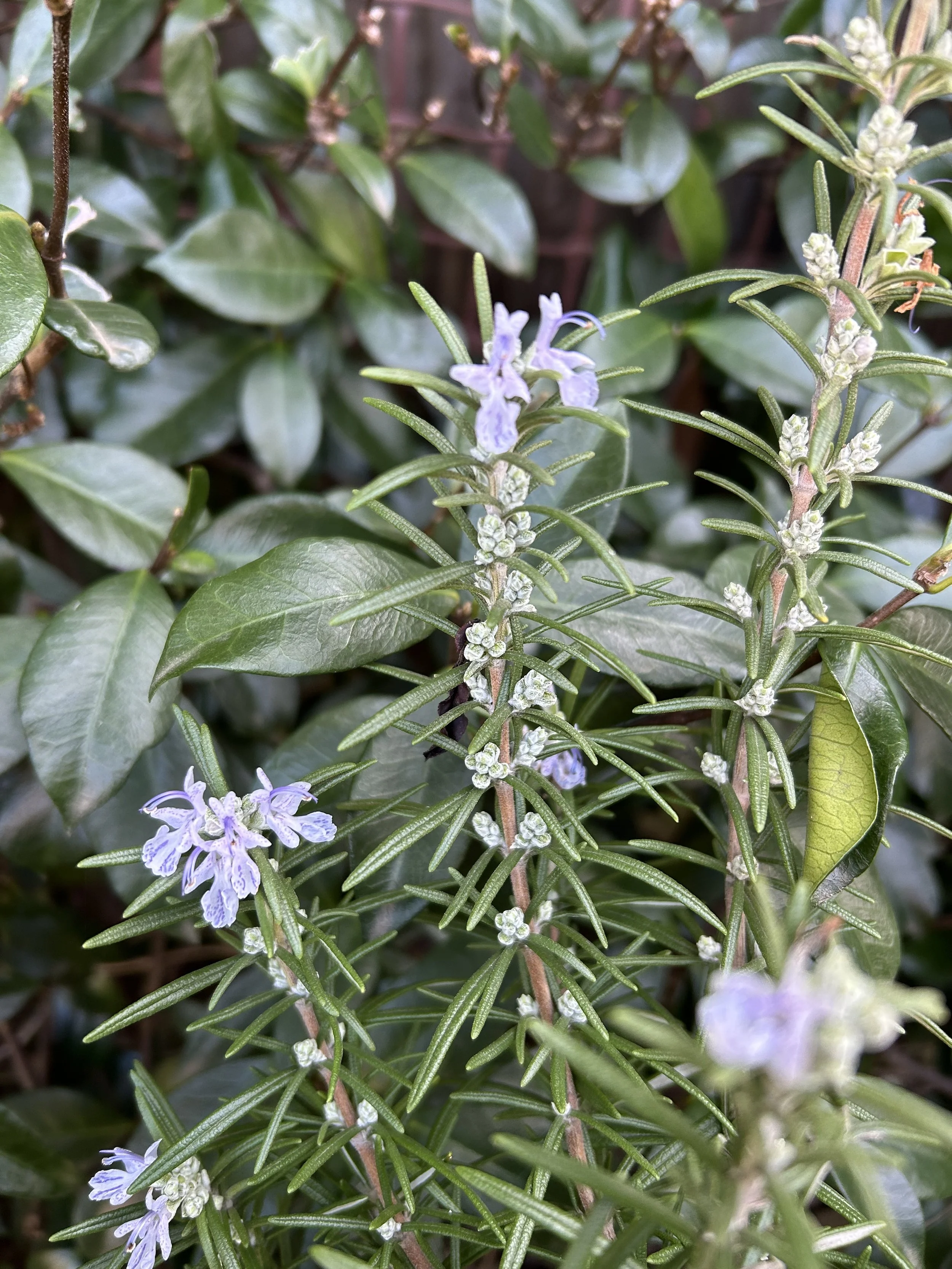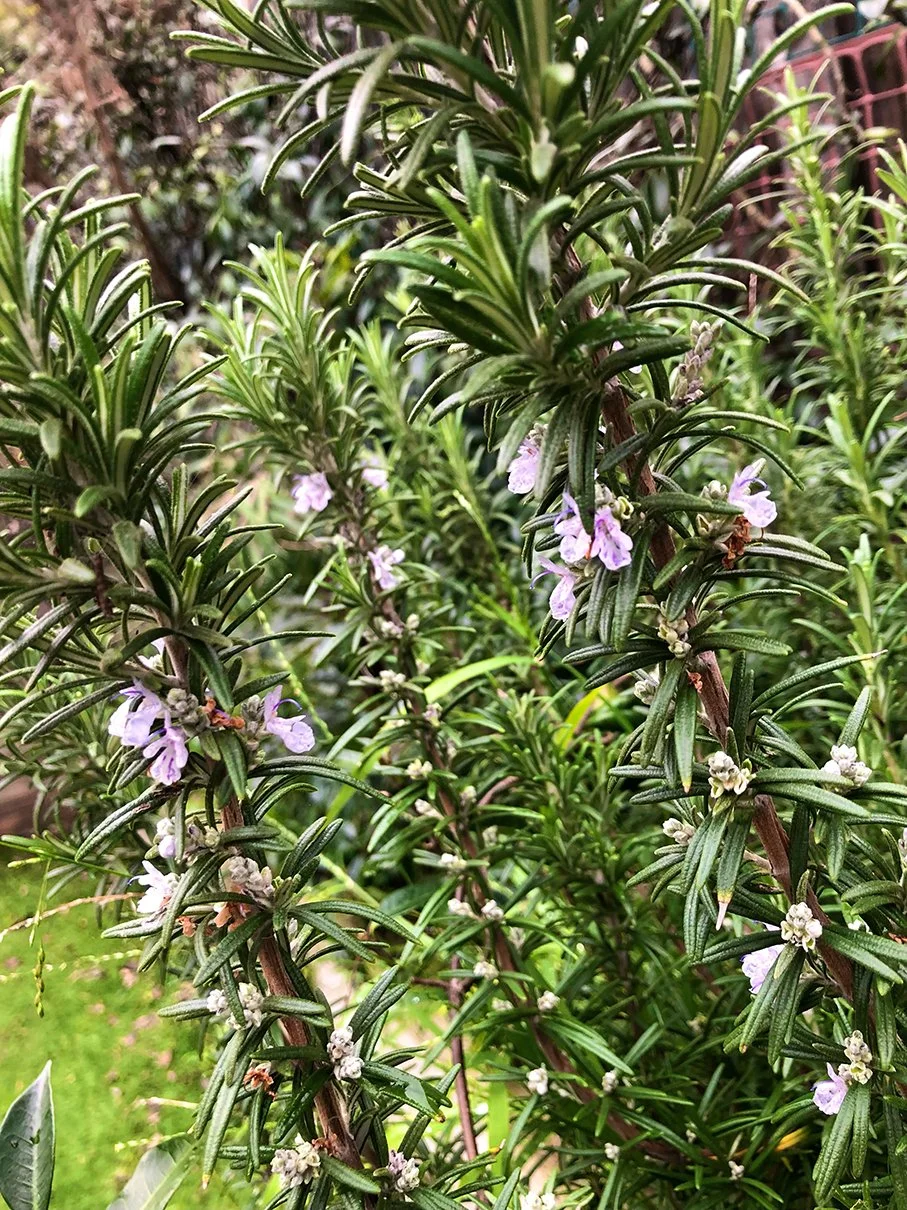Plant of the Season: Rosemary
Plant of the Season is brought to you by Gayle Parkes, OGV sub-committee member. She also posts to OGV's Instagram - make sure you check back regularly for her latest post.
Our winter plant of the season is Rosemary
In the middle of our cold winter my rosemary bush is covered in the most beautiful aromatic blue flowers that the brave bees are just loving! How versatile is rosemary, medicinally, culinary and of course, an all round fabulous plant in any garden.
Rosmarinus is a small taxonomic clade of woody, perennial herbs with fragrant evergreen needle-like leaves in the family Lamiaceae, native to the Mediterranean Basin. In 2017 the species in the genus Rosmarinus were moved into the large genus Salvia based on taxonomic evidence. (Wikipedia)
This wonderful plant is readily available in different varieties and depending on what type you choose, is happy in pots, in our garden beds, in hanging baskets, cottage gardens, planted as a hedge, or in rockeries, spilling over a wall.
I use rosemary in so many different ways. There is always a jug full of rosemary sitting on my bench spreading its fragrance throughout the kitchen. I love to crush the leaves through my fingers whenever I brush past my lovely big pot of rosemary in the garden and I have to say, it is not a G & T for me without a sprig of it nestled next to the slice of lemon! We make an “oil brush” with a bunch of rosemary to add flavor to whatever we are barbeque-ing and I make skewers out of the older, stronger stems for lamb kebabs. Try making a smudge stick and tossing it into your next open fire! Heavenly!
A couple of popular varieties to look out for are -
Rosmarinus officinalis ‘Tuscan Blue’
Tuscan Blue quickly forms an upright shrub and as its name suggests, it flowers in a pale blue. A taller rosemary, 1.5m x 1.5m. It takes to pruning well, so is perfect for a medium size, if slightly informal hedge with its upright habit.
Rosmarinus officinalis ‘Blue Lagoon’
Blue Lagoon is a low growing, compact trailing shrub that grows about 1m tall and 1m across. It is very impressive when blooming as it’s just a mass of blue/purple flowers. Looks great on banks or in rockeries. Great in pots. Good for seaside planting. Can also be used for hedging as it loves a trim.
Rosmarinus officinalis ‘Prostratus’
Prostrate or Creeping Rosemary is a fast growing, hardy shrub. It has the same attractive flowers and classic aroma as common rosemary, but grows low and spreading along the ground, making it an excellent ground cover, and is great to use in rock gardens or at the edge of large containers or in hanging baskets, cascading beautifully.
Rosemary is a drought-tolerant woody perennial herb with fragrant evergreen needle like leaves and white, pink, purple or blue flowers. It's a native of the Mediterranean region and is part of the large mint or Lamiaceae family which also includes many other herbs.
Rosemary loves to bask in full sun. It is easy to grow when planted in well-draining sandy or loamy soil but it can get root rot in overly wet or cold soil. Great for seaside plantings. A slightly acidic to neutral soil pH is ideal. It does like to be tidied up with a bit of a prune. This happens naturally in my garden, just by picking it for use in my cooking or adding it to my vase of pretty flowers.
The good thing about pruning is that you can use the prunings as cuttings.
Propagating rosemary is pretty easy. Take a cutting from a mature plant in the spring or summer. Cut a few inches of healthy new softwood growth and strip off the lower leaves (keep a few at the top of the stem). Dip the end of the cutting in rooting hormone. It's important to poke a hole in the moist sandy potting mix first, pop the cutting in, and then firm the potting mix down.
Or, keep the cutting in a container of fresh water. Either way, place the cutting in a warm, bright spot. The cutting is ready for transplanting after roots form.
Rosemary is recognised by modern-day practitioners of aromatherapy as an aid to mental clarity. It can also be dried and used in potpourri. The oil is often found in many perfumes and cosmetics. Since ancient times this aromatic herb was, and still is, believed to have properties to improve the memory. Perhaps because of this, rosemary became an emblem of both fidelity and remembrance in literature and folklore. Traditionally, sprigs of rosemary are worn on Anzac Day and sometimes on Remembrance Day. Rosemary has particular significance for Australians, as it is found growing wild on the Gallipoli peninsula.
The humble rosemary bush finds its way into most gardens, world wide, for so many different reasons and uses. But there's nothing better than throwing it in with the Sunday night roast lamb!





